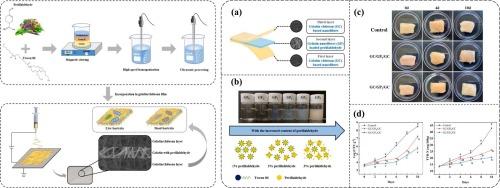一种新型明胶/壳聚糖基 "三明治 "抗菌纳米纤维薄膜,其中含有用于冷藏鸡肉保鲜的过氯醛
IF 5.4
2区 医学
Q2 MATERIALS SCIENCE, BIOMATERIALS
引用次数: 0
摘要
微生物导致的质量下降是食品工业的一个关键问题。为了增强冷鲜鸡肉的抗菌效果并延长其贮藏寿命,研究人员在两层明胶/壳聚糖(GC)纳米纤维之间夹层 GP2(明胶纳米纤维中含有 2 % (v/v) 的过氯醛),制备了一种基于明胶/壳聚糖(GC)的 "三明治 "纳米纤维薄膜。GP 纳米纤维的直径与紫苏醛浓度呈正相关。然而,GP 纳米纤维的热稳定性与之呈负相关。GP2 的热降解温度(Tm)最低。幸运的是,GC 纳米纤维将 GP2 的热降解温度从 98.91 °C 提高到了 111.60 °C。此外,1636 和 1442 cm-1 处的傅立叶变换红外吸收带表明紫苏醛被成功嵌入。此外,明胶纳米纤维较差的耐水性也得到了改善。具体来说,得益于紫苏醛和壳聚糖的协同作用,冷藏鸡肉的保质期得以有效延长(超过 10 天)。因此,这种 "三明治 "纳米纤维薄膜有望用于食品包装。本文章由计算机程序翻译,如有差异,请以英文原文为准。

A novel gelatin/chitosan-based “sandwich” antibacterial nanofiber film loaded with perillaldehyde for the preservation of chilled chicken
Quality deterioration caused by microorganisms is a crucial problem in food industry. Herein, to enhance the antibacterial effect and extend the storage life of chilled chicken, a gelatin/chitosan (GC)-based “sandwich” nanofiber film was prepared by sandwiching GP2 (gelatin nanofibers loaded with 2 % (v/v) perillaldehyde) between two layers of GC nanofibers. The diameter of GP nanofibers was positively correlated with perillaldehyde concentration. However, the thermal stability of GP nanofibers was negatively correlated. The thermal degradation temperature (Tm) of GP2 was the lowest. Fortunately, GC nanofibers improved Tm of GP2 from 98.91 °C to 111.60 °C. Besides, FTIR absorption bands at 1636 and 1442 cm−1 indicated that perillaldehyde was successfully embedded. Moreover, poor water resistance of gelatin nanofibers was also improved. Specifically, benefiting from the synergy between perillaldehyde and chitosan, the shelf-life of chilled chicken was efficiently prolonged (over 10 days). Thus, this “sandwich” nanofiber film shows promise for food packaging.
求助全文
通过发布文献求助,成功后即可免费获取论文全文。
去求助
来源期刊

ACS Biomaterials Science & Engineering
Materials Science-Biomaterials
CiteScore
10.30
自引率
3.40%
发文量
413
期刊介绍:
ACS Biomaterials Science & Engineering is the leading journal in the field of biomaterials, serving as an international forum for publishing cutting-edge research and innovative ideas on a broad range of topics:
Applications and Health – implantable tissues and devices, prosthesis, health risks, toxicology
Bio-interactions and Bio-compatibility – material-biology interactions, chemical/morphological/structural communication, mechanobiology, signaling and biological responses, immuno-engineering, calcification, coatings, corrosion and degradation of biomaterials and devices, biophysical regulation of cell functions
Characterization, Synthesis, and Modification – new biomaterials, bioinspired and biomimetic approaches to biomaterials, exploiting structural hierarchy and architectural control, combinatorial strategies for biomaterials discovery, genetic biomaterials design, synthetic biology, new composite systems, bionics, polymer synthesis
Controlled Release and Delivery Systems – biomaterial-based drug and gene delivery, bio-responsive delivery of regulatory molecules, pharmaceutical engineering
Healthcare Advances – clinical translation, regulatory issues, patient safety, emerging trends
Imaging and Diagnostics – imaging agents and probes, theranostics, biosensors, monitoring
Manufacturing and Technology – 3D printing, inks, organ-on-a-chip, bioreactor/perfusion systems, microdevices, BioMEMS, optics and electronics interfaces with biomaterials, systems integration
Modeling and Informatics Tools – scaling methods to guide biomaterial design, predictive algorithms for structure-function, biomechanics, integrating bioinformatics with biomaterials discovery, metabolomics in the context of biomaterials
Tissue Engineering and Regenerative Medicine – basic and applied studies, cell therapies, scaffolds, vascularization, bioartificial organs, transplantation and functionality, cellular agriculture
 求助内容:
求助内容: 应助结果提醒方式:
应助结果提醒方式:


